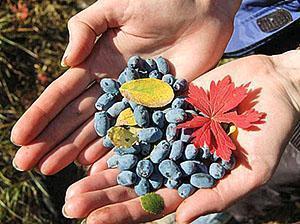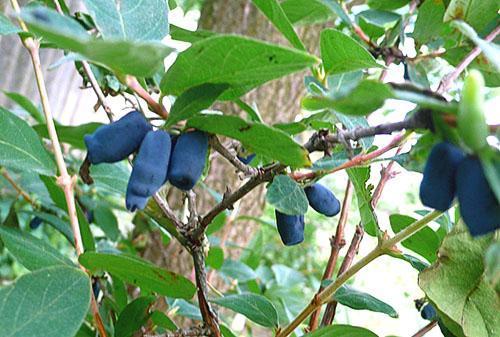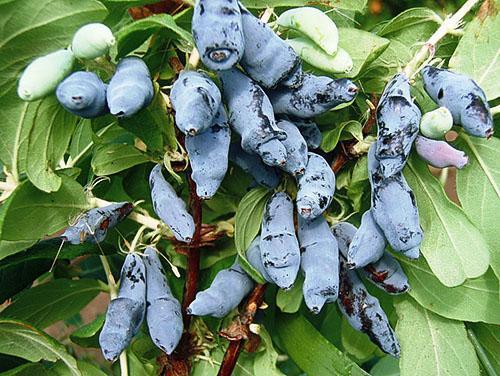Description of edible and decorative varieties of honeysuckle
 There are many varieties honeysuckle... They all have their own characteristics and distinctive features. At the same time, it is possible to distinguish edible varieties that give a good harvest and decorative varieties intended for decorating the garden. Also, varieties are distinguished by the ripening time. They can be:
There are many varieties honeysuckle... They all have their own characteristics and distinctive features. At the same time, it is possible to distinguish edible varieties that give a good harvest and decorative varieties intended for decorating the garden. Also, varieties are distinguished by the ripening time. They can be:
- early maturing;
- mid-season;
- late ripening.
If you plant different varieties of honeysuckle on your site, their description is given below, then you can harvest for 3 to 4 weeks.
Early Ripening Edible Honeysuckle
Early ripening edible honeysuckle varieties will bear fruit earlier than all other berries. Moreover, they are valued for their taste and medicinal properties.
Blue bird variety

The Blue Bird variety is self-fertile. In order for it to bear fruit, it is necessary to plant several more types of self-pollinated honeysuckle. Cross-pollination will allow for a good harvest.
Honeysuckle Leningrad giant
 Another early variety can be considered the honeysuckle Leningrad giant. Its berries are rather large and elongated, with a sweet and sour taste and strong aroma. The bush can grow more than one and a half meters high. It tolerates winter well and is resistant to diseases and all kinds of pests... In order for the bush to bear fruit, it is necessary to plant a number of pollinating varieties. They can be Morena, Malvina, etc.
Another early variety can be considered the honeysuckle Leningrad giant. Its berries are rather large and elongated, with a sweet and sour taste and strong aroma. The bush can grow more than one and a half meters high. It tolerates winter well and is resistant to diseases and all kinds of pests... In order for the bush to bear fruit, it is necessary to plant a number of pollinating varieties. They can be Morena, Malvina, etc.
Honeysuckle Morena
 Morena's honeysuckle is considered to be early maturing, a description of which is given. It is characterized as a hardy crop with large fruits (2.5 - 3 cm) and high yield. The berries have a sweet and sour taste and a faint aroma. This variety is self-pollinated, so it does not need additional varieties in the neighborhood. The fruits keep well on the bush for a long time and do not crumble.
Morena's honeysuckle is considered to be early maturing, a description of which is given. It is characterized as a hardy crop with large fruits (2.5 - 3 cm) and high yield. The berries have a sweet and sour taste and a faint aroma. This variety is self-pollinated, so it does not need additional varieties in the neighborhood. The fruits keep well on the bush for a long time and do not crumble.
Medium-ripened edible honeysuckle
Honeysuckle Bakcharian giant
 One of the medium-ripening varieties is the Bakcharsky giant honeysuckle. The berries are large (4 - 5 cm), and the bushes grow to almost two meters. The fruits have a sweet and sour taste and ripen at the end of June. Their flesh is tender, and the bones are practically not felt. The bush will begin to bear fruit in 2 - 3 years after planting. For good fertility, several varieties should be planted side by side, such as: Bakchara, Lazurnaya, etc.
One of the medium-ripening varieties is the Bakcharsky giant honeysuckle. The berries are large (4 - 5 cm), and the bushes grow to almost two meters. The fruits have a sweet and sour taste and ripen at the end of June. Their flesh is tender, and the bones are practically not felt. The bush will begin to bear fruit in 2 - 3 years after planting. For good fertility, several varieties should be planted side by side, such as: Bakchara, Lazurnaya, etc.
The berries of the Bakcharsky giant variety begin to crumble quickly, therefore, after they ripen, it is better to harvest immediately, and not postpone until a later date.
Honeysuckle variety Amphora
 Amphora honeysuckle can be considered a universal period of medium ripening. Its berries grow large in size and are pitcher-shaped. Their taste is slightly sour and reminiscent of lingonberries. The fruits have a thick skin, which is convenient for transportation. Due to its high yield, the variety can be of great benefit. Amphora is a self-fertile variety, so other varieties need to be planted nearby. This honeysuckle is resistant to shedding and does not bloom again.
Amphora honeysuckle can be considered a universal period of medium ripening. Its berries grow large in size and are pitcher-shaped. Their taste is slightly sour and reminiscent of lingonberries. The fruits have a thick skin, which is convenient for transportation. Due to its high yield, the variety can be of great benefit. Amphora is a self-fertile variety, so other varieties need to be planted nearby. This honeysuckle is resistant to shedding and does not bloom again.
Variety Raisin
 Honeysuckle raisin also belongs to medium ripening varieties. Its fruits are large enough up to 2.6 g each.Elongated berries are blue and bluish. When ripe, they practically do not fall. You can use them in any form. The taste of the berries is sweet, without any bitterness. The bushes of this variety are medium-sized and slightly spreading. It grows well in sunny places and withstands winter firmly.
Honeysuckle raisin also belongs to medium ripening varieties. Its fruits are large enough up to 2.6 g each.Elongated berries are blue and bluish. When ripe, they practically do not fall. You can use them in any form. The taste of the berries is sweet, without any bitterness. The bushes of this variety are medium-sized and slightly spreading. It grows well in sunny places and withstands winter firmly.
Honeysuckle Azure
 The shrub ripens closer to mid-June. Its berries are quite resistant. They do not crumble and ripen together. The fruits have a sweet and sour taste, and the aroma is reminiscent of blueberries. When planting this variety, a more illuminated place should be chosen. In addition, you need to take into account that the bushes are not too close to each other, because they can grow in width. The optimal distance between them is 1.5 meters.
The shrub ripens closer to mid-June. Its berries are quite resistant. They do not crumble and ripen together. The fruits have a sweet and sour taste, and the aroma is reminiscent of blueberries. When planting this variety, a more illuminated place should be chosen. In addition, you need to take into account that the bushes are not too close to each other, because they can grow in width. The optimal distance between them is 1.5 meters.
You should be aware that a warm autumn can provoke re-flowering. Because of this, there may be no harvest next year.
Edible varieties of late ripening honeysuckle
Honeysuckle Kamchadalka
 The Kamchadalk honeysuckle is considered a representative of the late ripening period. Her bush is compact and medium-sized. It can reach a height of 1.5 meters. The berries are blue-blue in color and covered with a waxy coating. They have a sweet and sour taste and strong aroma. The fruits do not crumble as they are chanted and are torn off rather difficult.
The Kamchadalk honeysuckle is considered a representative of the late ripening period. Her bush is compact and medium-sized. It can reach a height of 1.5 meters. The berries are blue-blue in color and covered with a waxy coating. They have a sweet and sour taste and strong aroma. The fruits do not crumble as they are chanted and are torn off rather difficult.
Kamchadalka can grow both in the sun and in the shade, but the first option is more preferable, since the shrub does not bear fruit well in partial shade. In addition, the plant is self-fertile. It will give a good harvest if varieties are planted nearby: In Memory of Gidzyuk, Cinderella, Blue spindleand others. The bush will bear fruit for 3 - 4 years after planting. He will give a crop every year.
Decorative varieties of honeysuckle
Ornamental varieties of honeysuckle can serve as a wonderful decoration for a garden plot. They look especially impressive during the flowering period. Such honeysuckle is not whimsical and grows in the form of a dense liana, which can braid a gazebo, arch, fence, etc. Depending on the variety, it will have a different color scheme and a different flowering period.
Honeysuckle varieties Serotina
 One of the ornamental varieties that deserves attention is Serotin's honeysuckle. It is a decorative vine with beautiful flowers, which later become decorative red fruits. Initially, the flower buds have a red-burgundy color, and after they bloom, a creamy core is visible. Such honeysuckle blooms from June to autumn. The scent of flowers is reminiscent of linden and is especially felt in the evening. Liana of this variety can grow 3 - 4 m in height. Each year, it can grow another 1 m. For the winter, it is better to remove it from the supports and put it in a horizontal position, but you can not cover it.
One of the ornamental varieties that deserves attention is Serotin's honeysuckle. It is a decorative vine with beautiful flowers, which later become decorative red fruits. Initially, the flower buds have a red-burgundy color, and after they bloom, a creamy core is visible. Such honeysuckle blooms from June to autumn. The scent of flowers is reminiscent of linden and is especially felt in the evening. Liana of this variety can grow 3 - 4 m in height. Each year, it can grow another 1 m. For the winter, it is better to remove it from the supports and put it in a horizontal position, but you can not cover it.
Ornamental variety - Brown's honeysuckle
 The main advantage of this variety is its extraordinary flowers. They have a bright orange-orange color. Flowers are strewn with liana in large clusters. This honeysuckle has a long flowering period (June to October) and does not grow as fast in height as other varieties. This is convenient for small gardens. After flowering, tough fruits appear on the bushes, which are not suitable for human consumption.
The main advantage of this variety is its extraordinary flowers. They have a bright orange-orange color. Flowers are strewn with liana in large clusters. This honeysuckle has a long flowering period (June to October) and does not grow as fast in height as other varieties. This is convenient for small gardens. After flowering, tough fruits appear on the bushes, which are not suitable for human consumption.
Brown is a thermophilic honeysuckle variety. For the winter, it is better to cover its shoots with a film or dry leaves, otherwise it may disappear.
Forest honeysuckle
 Forest honeysuckle is also considered a decorative variety. Often called wolf berries, it grows in the forest. Despite this, recently it has become more often used to decorate the site. This honeysuckle grows as a small shrub and begins to bloom in May with white flowers. In mid-June, dark red berries appear on the bushes. They grow together in pairs at the base. They cannot be eaten, but can be used medicinally. Such honeysuckle heals wounds well, has an antibacterial and analgesic agent.
Forest honeysuckle is also considered a decorative variety. Often called wolf berries, it grows in the forest. Despite this, recently it has become more often used to decorate the site. This honeysuckle grows as a small shrub and begins to bloom in May with white flowers. In mid-June, dark red berries appear on the bushes. They grow together in pairs at the base. They cannot be eaten, but can be used medicinally. Such honeysuckle heals wounds well, has an antibacterial and analgesic agent.
Due to the fact that Forest Honeysuckle is accustomed to wild growing conditions, it does not require special care. The shrub reproduces independently in a vegetative way, its branches fall on the ground, after which they take root themselves.